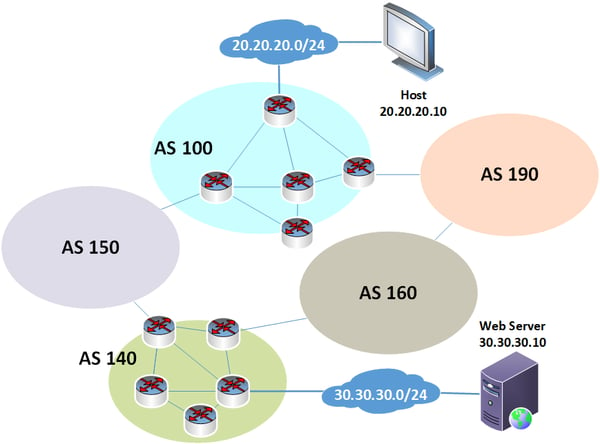
When you make a VoIP call or join a UC meeting, you click the “call” or “join” button, and everything just works! You seamlessly communicate with your remote employees, partners, and customers. It seems like magic, but behind the scenes, a vital technology is making all this possible: the Border Gateway Protocol (BGP).
BGP is the de facto routing protocol that governs and enables data to traverse the worldwide web. For VoIP and UC professionals, understanding BGP matters because it directly affects how voice, video, and messaging traffic reaches its destination. This is true for all communications taking place over the internet, such as that between users, SIP trunk providers, or cloud-based UC and VoIP platforms.
In this article, we look behind the scenes to see what BGP is, how it directs traffic across multiple networks and ISPs worldwide, and how its operation directly affects reliability and service availability for real-time applications.
A brief history of BGP
First introduced in 1989 in RFC 1105, BGP has been directing traffic over the internet for over 35 years and is expected to continue doing so for the foreseeable future. This is a testament to the innovation and foresight of its original design.
Of course, BGP has undergone several iterations of revisions and updates over the years to enhance and improve its operation and to accommodate the advent of new related protocols such as IPv6. However, its fundamental design remains intact.
Today, BGP is responsible for ensuring that routers—the devices that make routing decisions to direct packets through the internet—have up-to-date information about how to reach different destinations. BGP is also widely used within private networks. It is extensively deployed at the enterprise network edge as well as in private ISP networks supporting MPLS, VXLAN, and similar technologies.
The structure of the internet
The internet can be thought of as a network of networks. Each network is called an autonomous system (AS), and each AS is assigned a unique number. These autonomous systems are interconnected, creating this network of networks, and they exchange traffic with each other based on specific agreements and traffic volume thresholds.
At the very highest level, looking down on the internet, we would see something like this:

How BGP works
Each AS advertises the IP addresses of the devices it contains to the rest of the world. For example, in the diagram above, AS 140 must advertise to the rest of the world that the 30.30.30.0/24 network belongs to it so that everyone who attempts to reach the web server at the address 30.30.30.10 will be routed to that network and device.
BGP is designed to allow autonomous systems to share this information by establishing peerings between BGP routers like this:

The above diagram illustrates the BGP peerings between routers in AS 140 and AS 150 and between BGP routers in AS 100 and AS 150. Such peerings, however, exist between all autonomous systems, which is how they are interconnected.
Based on the establishment of these BGP peerings, autonomous systems exchange routing information. Parameters known as BGP attributes are advertised along with the IP addresses of specific destinations, which BGP uses to determine the best path to reach each destination.
Unlike other IP routing protocols that choose the shortest route as the best route, such as OSPF and EIGRP, BGP’s best path algorithm is more complex. It looks at distance, but it is also concerned with routing policies that are built into the agreements made between owners of the autonomous systems. This means that many more variables are considered in deciding on the best path.
For example, if the host in the diagram above wants to reach the web server at 30.30.30.10, BGP knows two possible paths, as shown below:

BGP paths are always described as a list of AS numbers, indicating which must be traversed to reach the AS within which the destination IP resides. This list is known as an AS path. The two AS paths depicted above are:
- 100 150 140
- 100 190 160 140
The first is the shorter path, but as mentioned earlier, BGP doesn’t use only the shortest path as the criterion for the best path but rather a whole series of additional attributes. These include attributes such as local preference, multi-exit discriminator (MED), origin type, next-hop reachability, and various BGP policies and preferences. All of these can be adjusted and fine-tuned to a very high degree based on the business agreements and technical policies established between AS owners.
Why BGP is critical for VoIP and UC services
Several trends in VoIP and UC are driving a growing reliance on the internet for service delivery and connectivity:
- VoIP and UC services are being delivered using cloud-based SaaS infrastructure.
- More and more employers and employees prefer to operate within a distributed and/or hybrid workforce arrangement.
- Virtual meetings are increasingly preferred over face-to-face meetings, reducing travel time and costs.
BGP, as a fundamental component of the reliable operation of the internet, must ensure reachability between SIP endpoints, IP PBXs, UCaaS platforms, cloud-based infrastructure, and remote users. BGP enables internet operation and, when properly deployed, can also offer redundancy and failover features.
BGP can be deployed using a reliability technique known as multi-homing. This technique allows a network to be connected to multiple ISPs, and thus, to multiple autonomous systems. This is known as a “multi-homed” design and ensures that even if one ISP or AS fails, alternative routing via BGP can be achieved via the remaining ISP. Multi-homing can be deployed at both the network edge and the location of interconnection between autonomous systems. It is also often deployed at the edge of a SaaS infrastructure to ensure that a cloud-based VoIP or UC service is still reachable if a part of the network fails.
In the following diagram, the SaaS based VoIP or UC service is multi-homed using BGP to two autonomous systems, ensuring that it is reachable even if either AS 140 or AS 160 fails.

An additional feature of BGP that provides redundancy on a broader scope is known as geo-redundancy, which helps keep VoIP and UC services available across multiple data centers or regions by using BGP to announce the same IP prefixes from different geographic locations. This allows traffic to automatically reroute to an alternate site if one location becomes unreachable.
Summary of BGP characteristics for VoIP/UC
BGP enables global reachability and reliability—both vital for today’s VoIP and UC systems. It is beneficial for professionals involved with these real-time communication services to understand the basics of BGP and partner with providers who handle BGP responsibly. If your VoIP or UC service depends on the internet—and most do—understanding how BGP works will help you to gain valuable insight into how the required end-to-end communication takes place.
Conclusion
Among the wide variety of technologies that allow our modern world to operate, few are as essential as BGP. Even though it may not be widely known, BGP quietly manages how data finds its way across the world's networks. The protocol remains at the very heart of the internet's operation and ensures the reliability and availability of UC and VoIP systems.
You may also like:
How to use SNMP to monitor your VoIP network
Minimize jitter, latency and other UC issues through proper routing
Nine DHCP options that are particularly useful for VoIP and UC









Comments